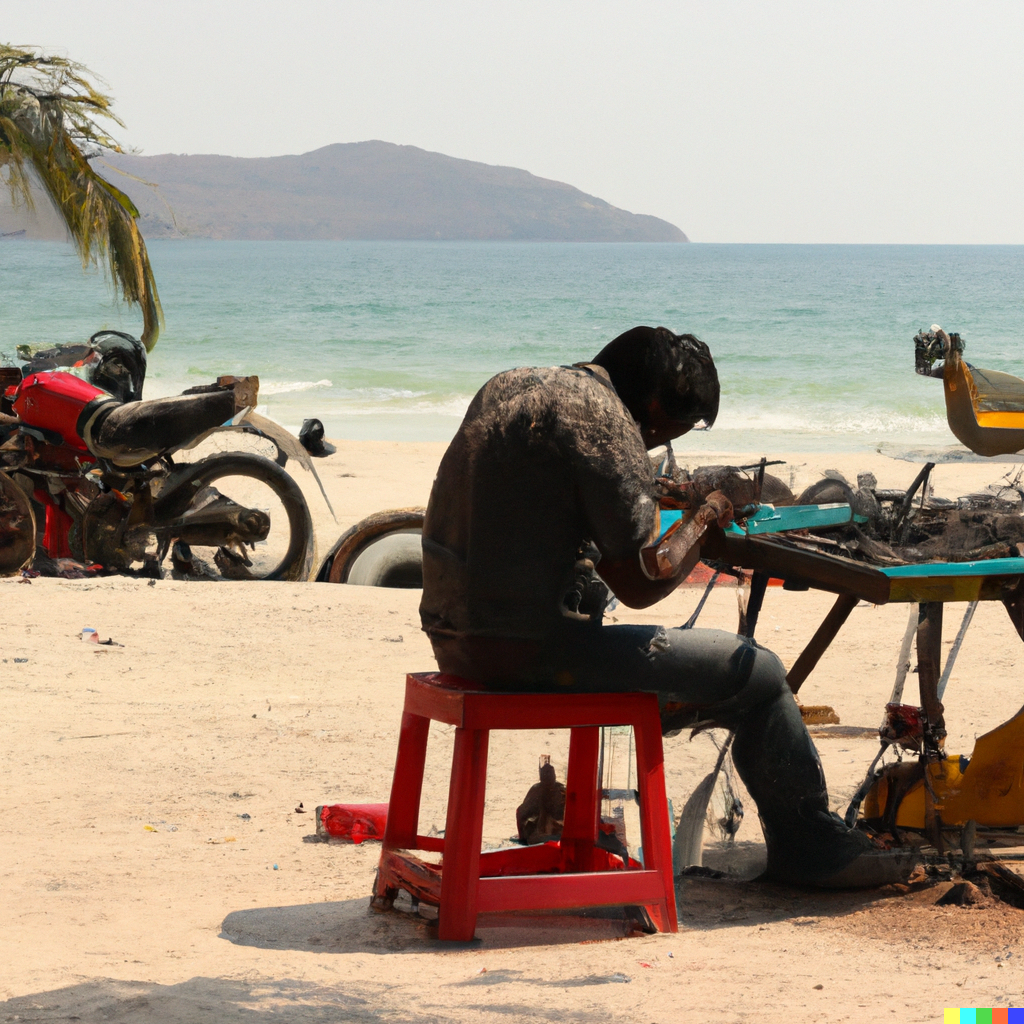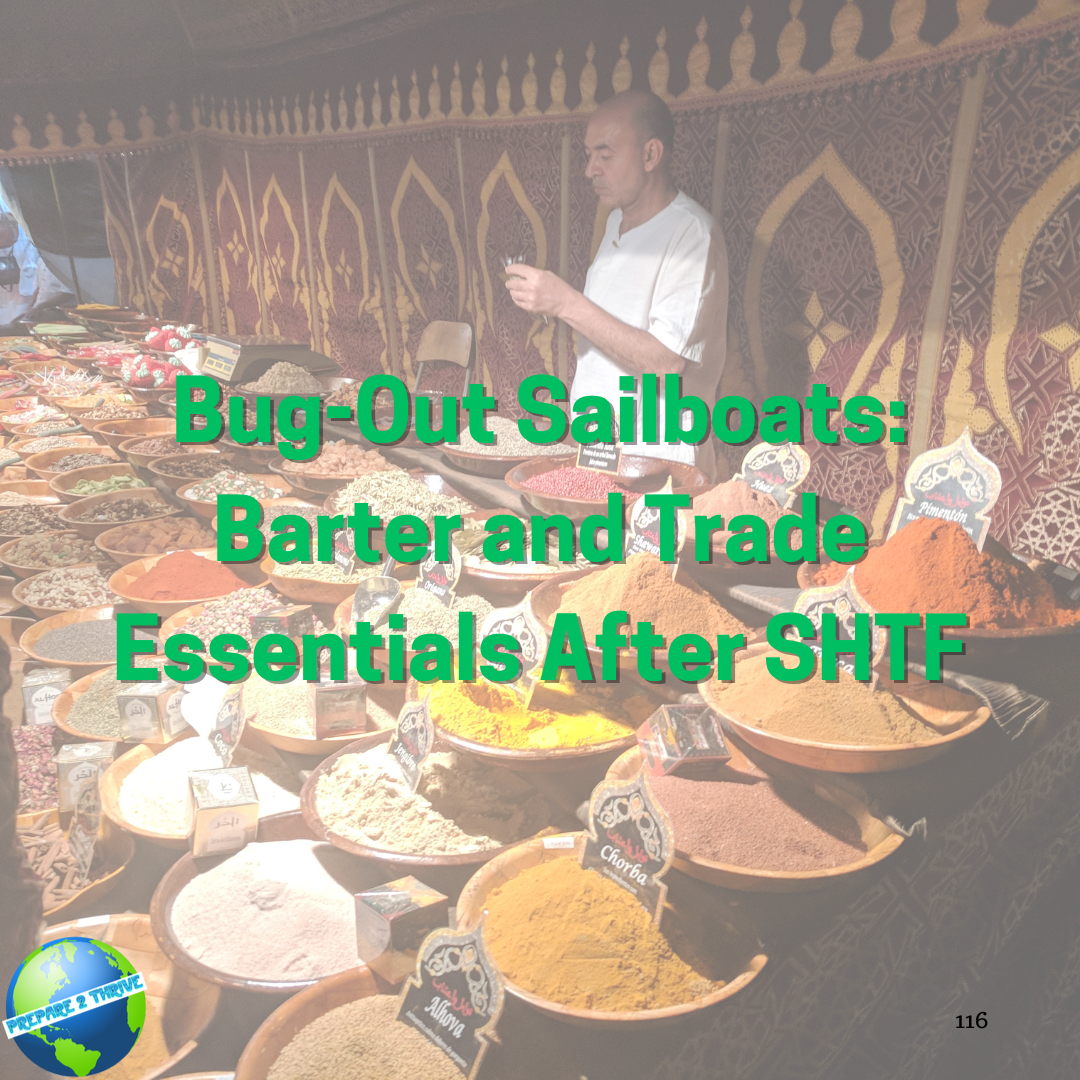I. Introduction
In an ever-changing world, the concept of preparedness has taken on new dimensions. The unpredictable nature of disasters and societal disruptions has led many to consider alternative strategies for survival beyond the conventional. One such strategy that has gained traction among preppers and survivalists is the utilization of bug-out sailboats. These seaworthy vessels not only provide a means of escape and mobility in times of crisis but also serve as a unique platform for one of the most critical aspects of survival: barter and trade.
A New Dawn of Exchange
When disaster strikes and the delicate threads of modern society unravel, the value of traditional currency can swiftly diminish. As supply chains crumble and the availability of goods becomes uncertain, communities are forced to rediscover age-old methods of trade and exchange. In this brave new world, bartering is resurrected as a cornerstone of survival. Items that were once taken for granted - food, water, shelter, and even knowledge - take on new significance as the currency of this changed landscape.
Navigating the Barter Seas
Enter the bug-out sailboat, a vessel uniquely poised to navigate the uncharted waters of post-SHTF (S**it Hits The Fan) scenarios. These sailboats offer more than just a means of escape - they provide a versatile platform for barter and trade. With the ability to move swiftly along coastlines and between isolated communities, sailboats become the lifeblood of commerce in a world where overland travel might be treacherous or impractical.
In addition to their mobility, bug-out sailboats offer self-sustainability through fishing, water collection, and energy generation. This self-sufficiency not only ensures survival for those aboard but also establishes sailboats as a valuable source of resources for trade. Furthermore, the isolation provided by being at sea offers a level of security from land-based threats, making these vessels a safer space for conducting transactions.
In the following sections of this article, we will delve deeper into the crucial role that bug-out sailboats can play in enabling barter and trade after SHTF. We will explore the essential goods that every individual will seek, strategies for effective negotiation, and the nuances of building a barter and trade network in a maritime context. Through the lens of survival, the art of trade takes on a renewed importance, and bug-out sailboats become the catalysts for a new era of post-apocalyptic commerce.
B. The Significance of Barter and Trade in a Survival Scenario
In the aftermath of a catastrophic event, the world as we know it can change dramatically. The familiar structures of commerce, banking, and currency may crumble under the weight of the crisis, leaving individuals and communities to fend for themselves. In this new reality, the age-old practice of barter and trade rises to the forefront as a means of obtaining essential goods and services.
1. Adapting to a Currencyless Landscape
The fragility of modern economies is laid bare during times of crisis. Inflation, scarcity, and the collapse of financial institutions can render traditional currency almost worthless. However, human needs do not disappear. The quest for sustenance, shelter, medical care, and security remains unchanged. This is where barter and trade come into play - a system based on mutual exchange and the inherent value of goods and services.
2. The Value of Goods in a New Light
As society reverts to a more localized and self-sufficient state, the importance of various goods takes on a new dimension. Items that were once taken for granted become precious commodities. Food becomes currency, medical supplies become treasures, and tools become the keys to survival. In this landscape, the ability to recognize the value of different goods and negotiate their exchange becomes a vital skill.
3. Building a Resilient Network
Survival is not a solitary endeavor. Communities of like-minded individuals band together to share resources, knowledge, and protection. Barter and trade facilitate the creation of these networks, fostering collaboration and mutual support. As individuals come together to exchange goods and services, bonds are forged, and trust is established. Sailboats, as mobile hubs, offer the opportunity to expand these networks beyond immediate geographic constraints.
Sailboats: Navigating the Barter Seas
Bug-out sailboats emerge as a natural extension of the survivalist ethos, providing a dynamic solution to the challenges posed by a disrupted world. These vessels possess inherent advantages that position them as effective tools for barter and trade:
1. Mobility and Accessibility: Sailboats provide access to remote coastal areas and isolated communities that might be otherwise unreachable. This mobility enables the collection of unique tradeable resources and the establishment of trade connections across a wide geographical range.
2. Self-Sustainability: Equipped with fishing gear and water purification systems, sailboats offer a renewable source of food and water. This self-sufficiency not only supports those aboard but also provides commodities for trade, strengthening the vessel's role as a hub of exchange.
3. Security and Adaptability: The ability to set sail and move away from land-based threats is a significant advantage in uncertain times. Sailboats offer security and isolation, creating an environment conducive to safe negotiations and transactions.
In the subsequent sections of this article, we will delve deeper into the essential goods required for barter and trade, explore effective strategies for negotiation and exchange, and highlight the intricacies of establishing a barter network using bug-out sailboats. As the world transforms and survival becomes paramount, the importance of trade takes on a new significance, and bug-out sailboats become invaluable tools for navigating these uncharted waters of exchange.
II. The Significance of Barter and Trade in a Post-SHTF World
In the wake of a cataclysmic event that disrupts the fabric of society, the conventional norms that once governed commerce can crumble swiftly. Traditional currency, once a symbol of value and exchange, can lose its significance as the pillars of modern finance falter. This leaves a void that demands alternative means of exchange, giving rise to the revival of ancient practices: barter and trade.
A. The Erosion of Traditional Currency
Modern economies are intricately interwoven with complex financial systems that rely on stability and predictability. However, the aftermath of a SHTF scenario can shatter these systems, eroding the value and trust associated with traditional currency. Inflation, scarcity, and the collapse of central institutions can render paper money and digital transactions unreliable, if not entirely worthless.
The Need for Alternative Means of Exchange
In the absence of a stable currency, the human instinct to acquire goods and services does not dissipate. The void left by the crumbling financial infrastructure necessitates the emergence of alternative means of exchange. Barter, an age-old practice steeped in the history of civilizations, rises to prominence once again. Through direct trade, individuals can acquire essential resources, goods, and services by offering items of tangible value in return.
B. The Role of Bartering and Trading in Survival
In a world where the aisles of supermarkets lie empty, where medical facilities are strained beyond capacity, and where the certainty of sustenance is replaced by uncertainty, survival depends on resourcefulness. Barter and trade take center stage as a way to obtain what is needed for survival when the usual supply chains are disrupted.
Acquiring Essential Resources
Bartering and trading enable individuals to obtain the fundamental necessities of life: food, water, shelter, and medical supplies. These items become the new currency of survival, with their inherent value far surpassing that of any printed note. Individuals with skills or goods to offer in exchange for these essentials find themselves at an advantage in this new economic landscape.
C. Building Communities Through Cooperation
Survival is not a solitary endeavor; it is a collective pursuit that thrives on cooperation and collaboration. In the aftermath of a crisis, individuals and communities must come together to pool resources, knowledge, and skills. Barter and trade facilitate the creation of these networks, forging bonds that extend beyond mere transactions.
Fostering Trust and Unity
As individuals engage in barter and trade, trust becomes the cornerstone of these interactions. The process of negotiation and exchange requires transparency, fairness, and reliability. This fosters a sense of community and unity among individuals who recognize the mutual benefits of cooperation.
Beyond Transactions: The Social Fabric
Bartering is not just about trading goods; it is about creating relationships and shared destinies. When individuals collaborate for their common survival, a deeper sense of belonging emerges. This sense of community strengthens social ties, enhances security, and establishes a support system that can withstand the challenges of a post-SHTF world.
In the subsequent sections of this article, we will explore how bug-out sailboats, with their unique mobility and self-sustainability, can amplify the potential of barter and trade in a survival context. As we navigate the uncharted waters of this new world, the fundamental importance of trade takes on a renewed meaning, and the humble practice of bartering becomes a beacon of hope and resilience.
III. Bug-Out Sailboats: A Mobile Hub for Barter and Trade
In a world where survival hinges on adaptability and resourcefulness, bug-out sailboats emerge as versatile tools uniquely poised to facilitate barter and trade in the aftermath of a SHTF scenario. These seaworthy vessels not only offer a means of escape but also serve as dynamic platforms for economic exchange, amplifying the potential for survival in the face of adversity.
A. Advantages of Bug-Out Sailboats in a Survival Context
-
Mobility to Access Remote Locations and Communities
Bug-out sailboats possess a distinct advantage in their ability to navigate both open waters and coastal areas, granting access to regions that might remain isolated due to disrupted overland transportation. In a post-SHTF world, communities situated along coastlines or on islands could become vital trading partners. Sailboats enable individuals to establish connections and trade with these communities, broadening the scope of available resources and goods.
-
Self-Sustainability Through Fishing and Water Collection
One of the key survival challenges is acquiring sustenance. Bug-out sailboats offer a unique solution by enabling occupants to engage in fishing, a sustainable source of food. Moreover, equipped with water purification systems, these vessels can collect and purify water from the surrounding environment. This self-sufficiency not only ensures survival for those aboard but also provides surplus resources for trade with inland communities lacking access to marine resources.
-
Security from Land-Based Threats
Sailboats provide an inherent level of security by keeping potential threats at bay. Land-based dangers, such as marauders or hostile groups, become less formidable when one is safely afloat. This security blanket creates an environment conducive to negotiations and transactions, enhancing the safety and effectiveness of barter activities.
B. Sailboats as Trading Hubs: Adaptability and Reach
Bug-out sailboats possess attributes that position them as natural trading hubs, uniquely capable of fostering commerce and exchange in a post-SHTF world.
-
Adaptability to Trade Demand
Sailboats can be transformed into floating marketplaces, stocked with a variety of tradeable goods acquired through fishing, scavenging, or careful preparation. This adaptability allows the vessel to respond to the ever-changing demands of different communities and individuals. Whether it's medical supplies, tools, food, or other critical items, a well-equipped sailboat can cater to a wide range of trade needs.
-
Extended Reach and Trade Network
Sailboats are not confined to the limitations of traditional trade routes. Their mobility grants access to a diverse array of trading partners across vast coastlines and waterways. The vessel's reach can extend far beyond what is feasible for land-based trading caravans, creating opportunities to trade for resources that may be abundant in one region but scarce in another.
-
Barter Facilitation and Networking
Sailboats act as natural magnets for trade interactions. The presence of a sailboat in a community can signal an opportunity for barter and exchange. This, in turn, fosters the development of trade networks, as individuals and communities come to recognize the sailboat as a reliable and consistent source of essential goods. The vessel becomes a hub around which commerce and cooperation revolve.
In the upcoming sections of this article, we will delve into the essential goods required for effective barter and trade, strategies for successful negotiation, and the nuances of building a barter network in a maritime context. As the world undergoes transformation and survival becomes paramount, the role of bug-out sailboats in enabling barter and trade takes center stage, turning them into vessels of hope and opportunity in the face of uncertainty.
IV. Essential Goods for Barter and Trade
In a world reshaped by crisis, the barter and trade of essential goods become the backbone of survival. The value of traditional currency fades, replaced by tangible resources that sustain life. To navigate this new reality, individuals must understand the categories of essential goods that hold the key to barter success.
A. Categorizing Essential Goods into Basic Human Needs
-
Food and Water The foundation of survival lies in sustenance. Nutrient-rich food and clean water are paramount for health and vitality. Items like non-perishable food, seeds for cultivation, and water purification equipment become the currency of survival.
-
Shelter and Clothing Protection from the elements is critical. Whether it's sturdy shelter materials, warm clothing, or blankets, these items provide comfort and security in harsh environments.
-
Medical Supplies In a world without access to modern healthcare, medical supplies take on immense value. Bandages, antibiotics, pain relievers, and medical instruments become essential for treating injuries and illnesses.
-
Tools and Equipment Tools are the building blocks of self-sufficiency. Items like knives, multi-tools, hunting equipment, and farming implements empower individuals to gather resources and create necessary goods.
-
Information and Skills Knowledge becomes a form of wealth. The ability to provide information, teach skills, or offer specialized services like first aid, navigation, or repair work can be invaluable in a survival context.
B. The Crucial Role of Each Category and Scarcity's Influence on Value
-
Food and Water Scarcity of sustenance resources can quickly escalate into a life-threatening situation. As access to food and potable water becomes scarcer, these items gain immeasurable value. Those with a surplus of these resources hold considerable bargaining power.
-
Shelter and Clothing Shelter provides protection from the elements and security against predators. In regions with extreme weather conditions, the scarcity of suitable shelter materials or warm clothing can elevate their worth significantly.
-
Medical Supplies Medical emergencies are an inevitable part of life, especially in challenging environments. The scarcity of medical supplies can mean the difference between life and death, driving their value to astonishing heights.
-
Tools and Equipment Tools amplify human capacity and resource utilization. Scarcity of tools can hinder resource collection, construction, and survival-related activities, making these items a valuable commodity.
-
Information and Skills In a world where knowledge is power, the scarcity of individuals possessing specialized skills or information can lead to a demand for their expertise. The ability to navigate, forage, heal, or repair becomes not just a skill but a form of currency.
As the scarcity of these essential goods intensifies, their value in the barter market grows exponentially. The need to secure these resources drives individuals to seek out trading opportunities, forging connections and networks to access the items necessary for survival. In the forthcoming sections of this article, we will delve into strategies for effective negotiation, fostering a barter network, and maximizing the potential of bug-out sailboats as facilitators of survival commerce.
V. Bartering and Trading Strategies
In a world driven by the exchange of vital resources, successful bartering and trading can be the key to survival. Understanding the art of negotiation and exchange becomes paramount as individuals and communities navigate the landscape of scarcity and need.
A. Effective Negotiation and Exchange Techniques
-
Establish Fair Value: Understanding the relative worth of goods is essential. Before entering negotiations, research prevailing values to ensure equitable exchanges. Assess factors such as scarcity, demand, and utility to determine the value of items.
-
Build Relationships: Successful bartering often hinges on building trust and rapport. Engage in open communication, be transparent about your goods, and show willingness to collaborate. Establishing goodwill can lead to more favorable deals.
-
Bundle Goods: Consider offering a combination of goods to sweeten the deal. Packaging items that complement each other can make your offer more appealing and demonstrate flexibility in negotiation.
-
Negotiate with Respect: Approach negotiations with respect and patience. Pushing too aggressively can lead to distrust and failed exchanges. A mutually beneficial outcome is the goal, so be willing to compromise.
B. Assessing the Needs of Potential Trade Partners
-
Listen and Observe: When interacting with potential trade partners, listen attentively to their needs and observe their circumstances. Understanding their challenges and requirements will allow you to tailor your offers accordingly.
-
Identify Gaps: Look for gaps in their resources and identify items that could address their immediate needs. Offering goods that complement their existing assets showcases your willingness to fulfill their requirements.
-
Anticipate Trends: Stay attuned to changing conditions and emerging needs within the community. Anticipating trends and shifts in demand positions you as a reliable source for sought-after items.
C. The Value of Non-Tangible Assets
-
Expertise and Skills: Non-tangible assets like expertise or skills can be just as valuable as physical goods. Offering medical knowledge, survival skills, or specialized craftsmanship can secure essential resources in return.
-
Labor and Services: In a world where resources are scarce, providing labor or services can be a valuable form of trade. Repairing equipment, constructing shelter, or assisting with essential tasks can earn you necessary items in exchange.
-
Knowledge Sharing: Sharing valuable information, such as navigation tips, foraging techniques, or medical advice, can establish you as a respected source of knowledge within the barter community. This reputation can lead to more favorable trade opportunities.
As you navigate the landscape of bartering and trading, remember that successful exchanges are built on mutual benefit and respect. Fostering a reputation for fairness, reliability, and expertise will position you as a sought-after trade partner. In the following sections of this article, we will explore the nuances of building a barter network and maximizing the potential of bug-out sailboats as mobile hubs for trade in a post-SHTF world.
VI. Developing a Barter and Trade Network
In a world of scarcity and uncertainty, the establishment of a robust barter and trade network becomes a lifeline for survival. Building connections, forming alliances, and upholding ethical principles are essential for thriving in this new economic landscape.
A. The Need to Establish Connections
-
Survivalists and Communities: Reach out to like-minded individuals and communities that share your goal of preparedness and survival. Establishing connections with those who have diverse skills and resources can broaden your trading opportunities.
-
Sailors and Maritime Communities: Forge relationships with sailors and maritime communities along your sailboat's route. These connections expand your trading network, providing access to goods from different regions and tapping into specialized knowledge.
B. Advantages of Forming Alliances and Partnerships
-
Resource Pooling: Collaborating with others allows for resource pooling. By leveraging the collective assets of an alliance or partnership, you can offer a wider variety of tradeable goods, making your group more appealing to potential trade partners.
-
Security and Protection: In a world where security is paramount, alliances provide a layer of protection against threats. Safety in numbers can deter potential aggressors and increase your collective ability to defend against risks.
-
Shared Knowledge and Skills: Alliances facilitate the sharing of knowledge and skills. Learning from each other's expertise can enhance your group's self-sufficiency and make you valuable contributors to the barter network.
C. Tips on Maintaining Ethical and Fair Trade Practices
-
Transparency: Be transparent about the quality, condition, and quantity of the items you're trading. Misrepresentation erodes trust and can harm your reputation within the trading community.
-
Fairness: Strive for equitable exchanges that benefit all parties involved. Unfair practices can lead to resentment and breakdowns in trade relationships. A reputation for fairness enhances your standing in the network.
-
Consistency: Consistency in your trade practices builds reliability. Consistently delivering on your promises and maintaining ethical conduct will help you earn the trust of your trade partners.
-
Value Evaluation: Continuously assess the value of goods based on current conditions. As scarcity and demand change, your perception of value may need to adapt to ensure fair exchanges.
-
Communication: Effective communication is essential. Clearly articulate your needs, expectations, and what you can offer. Clear communication prevents misunderstandings and helps build strong trade relationships.
As you develop your barter and trade network, remember that mutual respect and cooperation are the cornerstones of success. By cultivating relationships, forming alliances, and upholding ethical principles, you contribute to a thriving network that benefits all involved parties. In the upcoming sections, we will explore the unique challenges and considerations of bartering in a maritime setting, along with case studies that illustrate successful barter and trade using bug-out sailboats.
VII. Unique Challenges and Considerations
Bartering and trading in a maritime setting presents a distinct set of challenges that require careful consideration and strategic planning. Navigating the open waters while engaging in exchanges demands adaptability and innovative solutions to overcome obstacles.
A. Addressing Potential Challenges of Bartering in a Maritime Setting
-
Limited Space on Sailboats for Storing Tradeable Items: Sailboats, while versatile, have finite storage capacities. This limitation poses a challenge when accumulating tradeable goods, especially when trying to accommodate a diverse range of items to meet various trade demands.
-
Navigational Risks and the Unpredictability of Weather: The unpredictability of weather conditions and the potential for encountering hazards like storms or rough seas pose significant challenges to maintaining a stable trading routine. Navigational risks can disrupt trading plans and even jeopardize the safety of the vessel.
B. Offering Solutions and Strategies to Overcome These Challenges
-
Strategic Inventory Management: Given the limited storage space, prioritize tradeable items that are versatile, high in demand, and have a long shelf life. Goods that address multiple needs, such as tools, medical supplies, and non-perishable foods, can maximize the utility of your limited space.
-
Flexible Trade Scheduling: Recognize the influence of weather and navigation on your trading activities. When planning trade stops, consider weather forecasts and avoid potentially hazardous conditions. Flexibility in your schedule can help you adapt to changing circumstances.
-
Compact and Durable Storage Solutions: Invest in efficient storage solutions that maximize the available space on your sailboat. Utilize collapsible containers, vacuum-sealed bags, and modular storage systems to organize and protect tradeable items without sacrificing space for essential supplies.
-
Trade Networks and Prearranged Stops: Establish a network of reliable trade partners in advance. By arranging for predetermined trade stops, you can minimize unnecessary deviations and optimize your trading routes, reducing the impact of unpredictable weather on your itinerary.
-
Weather Monitoring and Navigation Skills: Prioritize developing strong navigation skills and stay well-informed about weather patterns. Utilize modern navigation technology and rely on traditional navigational techniques to ensure safe journeys and informed decisions.
-
Diversification of Trade Locations: To mitigate navigational risks and adverse weather conditions, diversify your trade locations. Having multiple potential trading partners along your route allows you to adapt your plan based on prevailing conditions.
-
Emergency Preparedness: Prepare for emergencies by equipping your sailboat with emergency supplies, communication devices, and navigation tools. Should unexpected challenges arise, being well-prepared enhances your ability to navigate adversity.
By acknowledging these challenges and employing strategic solutions, you can navigate the complexities of maritime bartering while ensuring the safety of your vessel and the success of your trading endeavors. In the subsequent sections, we will delve into real-life case studies and examples that illustrate the practical application of bug-out sailboats as platforms for successful barter and trade post-SHTF.
VIII. Case Studies and Examples
Real-life examples and hypothetical scenarios illustrate the practicality of bug-out sailboats as effective platforms for barter and trade in a post-SHTF world. These stories offer insights into the challenges faced, the strategies employed, and the lessons to be learned from these survival-driven exchanges.
A. Showcasing Successful Barter and Trade Using Sailboats
Case Study 1: Coastal Community Exchange: A Tale of Survival and Cooperation

A sailboat named Horizon Seeker is anchored offshore.
The sun hung low on the horizon, casting a warm golden hue across the tranquil waters. In the aftermath of a devastating natural disaster, a group of survivalists found themselves aboard the sturdy deck of a well-equipped sailboat named "Horizon Seeker." With the local world around them forever changed, they had embarked on a journey of resilience, resourcefulness, and community.
Navigating the coastline that had once been familiar, but now bore the scars of upheaval, the crew of the Horizon Seeker had a mission: to establish connections with isolated communities and engage in barter and trade. They knew that survival was not just an individual endeavor - it was a collective effort that required cooperation and mutual support.
Their first stop was a coastal community nestled among rocky cliffs and sheltered coves. The villagers had weathered the storm with admirable tenacity, but their resources were dwindling, and the struggle for sustenance was real. As the Horizon Seeker anchored offshore, a delegation from the crew travelled to the shore to initiate negotiations.
Emily, a skilled nurse and one of the survivalists, led the group. With medical supplies carefully organized and inventoried, she presented their offerings to the villagers: bandages, antibiotics, pain relievers, and basic medical instruments. The villagers, in turn, showcased their locally sourced fruits, vegetables, and freshwater from their artesian well.
As the trade discussions began, Emily's calm demeanor and genuine concern for the villagers' well-being resonated with them. She shared stories of how she and her crew had meticulously prepared for emergencies, and how medical supplies had become invaluable in their survival journey. The villagers, in return, spoke of their struggles and their hopes for rebuilding their community.
The negotiation culminated in an exchange that brought both relief and hope. The Horizon Seeker's crew handed over medical supplies, providing the community with a lifeline for healing and recovery. In return, the villagers offered crates of fresh produce, clean water, and a sense of camaraderie that went beyond the transaction.
As the sailboat sailed on, its crew embarked on similar exchanges with other communities along the coast. At each stop, they tailored their offerings to meet the specific needs of the community they encountered. Their medical expertise, coupled with their strategic preparation, allowed them to not only secure sustenance but also to establish themselves as dependable trade partners.
With each successful trade, the connections deepened. The Horizon Seeker became more than a vessel; it transformed into a symbol of hope, collaboration, and survival. The crew learned valuable lessons about the power of empathy, the importance of sharing knowledge, and the resilience of humanity in the face of adversity.
In the end, the journey of the Horizon Seeker was a testament to the idea that in a world reshaped by catastrophe, the bonds forged through cooperation and trade could be the thread that weaves a new fabric of community. As the sailboat continued to navigate the coast, its sails billowing in the wind, it carried with it not only essential resources but also the promise of a brighter future built on shared strengths and enduring connections.
Case Study 2: Specialized Skills Exchange: A Journey of Repair and Reciprocity

where a skilled repairman works on a mechanical device.
The coastline stretched before him, a tapestry of rugged shores and secluded coves. Thomas, a solitary sailor, navigated his sailboat "Sea Mender" with the skill and precision that came from years of experience. But it wasn't just his seamanship that set him apart; it was his specialized skill set that would soon become a beacon of hope for the communities he encountered.
With a toolbox filled with an array of tools, from delicate instruments to heavy-duty machinery, Thomas embarked on a journey of survival and reciprocity. The world had changed after a series of cataclysmic events, and Thomas knew that his ability to repair and maintain essential equipment was a valuable currency in this new reality.
His first stop was a fishing village whose net-making equipment had fallen into disrepair. The villagers welcomed him, their wearied faces reflecting the struggle for sustenance. As Thomas assessed the damage, his fingers deftly moved over the tools, each touch guided by a depth of knowledge acquired through years of practice.
With dedication and focus, Thomas repaired the net-making machines, restoring the villagers' means of livelihood. The gratitude in their eyes was palpable, and they insisted on repaying him. But Thomas had a different request - food, clean water, and some basic tools. His sailboat was equipped with a compact garden, but the villagers' fresh catch and their well-maintained well water were treasures he couldn't easily replicate.
As the news of his skills spread, Thomas became a sought-after figure along the coastline. Village after village welcomed him, presenting broken tools, malfunctioning devices, and worn-out machinery. With each successful repair, he forged connections and built a reputation that extended beyond his technical abilities. He offered more than just repairs; he provided hope and a tangible reminder that resourcefulness could bridge the gap between scarcity and abundance.
In return for his services, Thomas received nourishment for his body and tools for his work. But there was something more intangible that he gained - a sense of purpose and belonging. The communities he encountered offered more than just material goods; they offered him stories of survival, resilience, and the human spirit's enduring capacity to adapt.
As Thomas continued his journey, he noticed a shift in the dynamic. The communities that had benefited from his skills were now coming together to share their resources and knowledge. They knew that in the face of uncertainty, collaboration was their strongest asset. Thomas became a part of this web of connection, an integral thread that strengthened their collective resilience.
As the sails of the "Sea Mender" caught the wind, Thomas reflected on his journey. The coastline had become a tapestry of relationships, each thread woven with trust and shared survival. His specialized skills had not only sustained him but had also ignited a spark of cooperation among the communities he encountered.
In this new world, where specialized skills held the power to heal and rebuild, Thomas had found his place. The sound of the waves and the hum of his tools were now the backdrop of his purpose - a purpose that echoed with the belief that in the midst of challenges, the exchange of skills and knowledge could be the catalyst for a brighter future.
B. Highlighting Lessons Learned
-
Diversification of Skills: Both case studies emphasize the importance of possessing diverse skills that contribute to the trade process. Whether it's medical expertise, repair skills, or specialized knowledge, being able to offer something unique strengthens your position in the barter network.
-
Adaptability: The flexibility to adapt your trade offerings based on the needs of the communities you encounter is crucial. Being open to negotiation and understanding the specific needs of potential trade partners enables you to strike more favorable deals.
-
Building Trust: Establishing trust through transparent and fair trade practices is essential. Trustworthy trade partners are more likely to attract favorable deals and build lasting alliances within the barter network.
-
Resource Management: Effectively managing your resources, both in terms of available tradeable goods and your vessel's supplies, is a key factor in successful trading. Prioritizing essential items and optimizing storage solutions maximizes your ability to trade effectively.
-
Planning and Preparation: Preparation is key to successful trading. Understanding the geographic landscape, weather patterns, and potential trade partners along your route allows you to strategize trade stops and make informed decisions.
-
Cultivating Relationships: Both case studies underscore the value of forming relationships and alliances with communities and individuals. By fostering connections based on mutual benefit, you can establish a sustainable and thriving barter network.
In the final section of this article, we'll conclude by recapping the importance of bug-out sailboats in enabling barter and trade, while encouraging readers to prepare for the challenges and opportunities that await in a transformed world.
IX. Conclusion
As we navigate the uncharted waters of a post-SHTF world, the significance of bug-out sailboats as facilitators of barter and trade shines brightly. In a landscape where traditional currencies falter and survival depends on resourcefulness, these seaworthy vessels emerge as beacons of hope and opportunity.
A. The Crucial Role of Bug-Out Sailboats in Facilitating Post-SHTF Barter and Trade
Bug-out sailboats offer a unique blend of mobility, self-sustainability, and security that position them as invaluable tools for survival commerce. Their ability to access remote communities, provide sustenance through fishing, and offer a secure environment for trade negotiations sets them apart. Sailboats become more than vessels; they become the hubs of economic exchange that connect individuals and communities across challenging landscapes.
B. Encouragement to Prepare and Build Valuable Skills
In a world where the rules of engagement have shifted, preparation becomes the foundation of survival. Accumulating tradeable resources that span the categories of food, water, shelter, medical supplies, tools, and knowledge is paramount. As the examples have shown, possession of specialized skills adds immeasurable value to your trade offerings. Invest in developing these skills, honing your knowledge, and fortifying your survival toolkit.
C. The Power of Adaptability and Collaboration
Adaptability and collaboration stand as guiding principles in this new world. The ability to pivot, innovate, and respond to emerging challenges will be essential. Building a network of trade partners and alliances enhances your collective strength, enabling you to overcome obstacles and thrive in an environment defined by scarcity and change.
As we look to the horizon of a transformed world, bug-out sailboats symbolize the resilience and resourcefulness that humanity is capable of. By harnessing their potential as trading hubs and combining it with strategic preparation, skills cultivation, and the power of community, we pave a path to survival, growth, and the reconstruction of a new society. The waves of change are upon us - let us ride them with the wind of preparation and collaboration at our backs.
X. Additional Resources
For those seeking to delve deeper into the world of survivalist strategies, bartering, and sailboats, a wealth of information awaits. Below are recommended reading materials, websites, and communities to further explore these topics:
Recommended Reading:
-
"The Modern Survival Manual: Surviving the Economic Collapse" by Fernando Aguirre
-
"SAS Survival Handbook: The Ultimate Guide to Surviving Anywhere" by John 'Lofty' Wiseman
-
"The Encyclopedia of Country Living" by Carla Emery
-
"Boatowner's Mechanical and Electrical Manual: How to Maintain, Repair, and Improve Your Boat's Essential Systems" by Nigel Calder
Websites and Communities:
-
SurvivalBlog - A comprehensive resource for survival and preparedness information, covering a wide range of topics. Website: https://survivalblog.com/
-
The Prepper Journal - An online platform offering articles, guides, and discussions on prepping and survival techniques. Website: https://theprepperjournal.com/
-
SailNet - An online community for sailors, offering forums, articles, and resources related to sailing and sailboat maintenance. Website: https://www.sailnet.com/
-
Cruisers Forum - A platform for sailors and cruisers to share information, advice, and experiences related to sailing and boating. Website: https://www.cruisersforum.com/
YouTube Channels:
-
The Urban Prepper - Offers practical prepping and survival advice for both urban and rural environments. Channel: The Urban Prepper
-
Sailing SV Delos - Chronicles the journey of a group of sailors living aboard a sailboat while exploring the world. Channel: Sailing SV Delos
-
Primitive Technology - Demonstrates primitive survival skills and techniques for self-sufficiency in the wilderness. Channel: Primitive Technology
These resources provide a starting point for your exploration into survivalist strategies, bartering techniques, and sailboat navigation. By immersing yourself in these communities and sources of information, you can enhance your understanding, hone your skills, and prepare for the challenges and opportunities that a post-SHTF world may bring.



